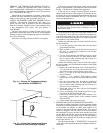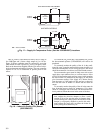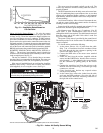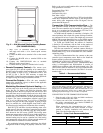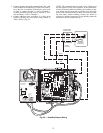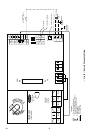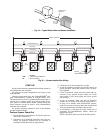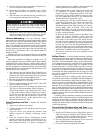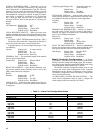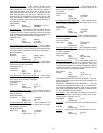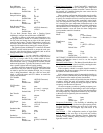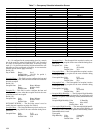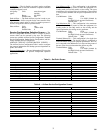
30
9. Check to be sure the area around the air handler(s) is
clear of construction dirt and debris.
10. Check that final filters are installed in the air han-
dler(s). Dust and debris can adversely affect system
operation.
11. Verify that the zone controller and the air handler con-
trols are properly connected to the CCN bus.
12. Remember to utilize good duct design and to provide
sufficient straight duct at the inlet of the box. A mini-
mum of three times the inlet size is recommended.
Network Addressing —
Use the following method
when all the zone controllers are installed and powered, and the
SPT sensors are wired and functioning properly. This method
can be used if no addresses have been set previously. The ad-
dress of an individual zone controller may be set by using the
address search function on the Service Tool software when it is
directly connected to the service port of the zone controller and
the CCN bus is disconnected. This is the standard method of
setting the address.
Addresses may also be set using the Service Tool Address
Search Function if the zone controller is isolated from the CCN
bus.
Each zone controller will default to an address of 0, 140
when its application software is initially loaded. Since multiple
controllers will be on the same bus, a unique address must be
assigned to each controller before the system can operate prop-
erly. The assignment of controller addresses will be performed
through software by using the Address Search function of the
Network Service Tool, as follows:
1. The software recognizes that the Zone Controller's ad-
dress, stored in the zone controller memory, has not been
written yet (this will be true when the unit is first powered
up on the job, or after a jumper-initiated reset).
2. Press the override button on the SPT (terminals J4-14 and
J4-12 are shorted) for 1 to 10 seconds.
3. The zone controller address changes from 0, 140 to 239,
239 for a period of 15 minutes.
4. Use Network Service Tool to change the address from
239, 239 to a valid system address within 15 minutes.
NOTE: If the address is not changed from 239, 239 to
a valid system address within 15 minutes, the control-
ler will revert to address 0, 140 and use of the override
button will cause the address function to repeat. The
operator MUST actively set the address even if the
final desired address is 0, 140.
Initial Operation and Test —
Perform the following
procedure:
1. Apply 24 vac power to the control.
2. Connect the service tool to the phone jack service port
of the controller.
3. Using the service tool, upload the controller from
address assigned in Network Addressing section
above.
4. From the Terminal Service Configuration screen,
properly configure the damper type and inlet size. If a
round inlet is used, then enter the size directly in the
Inlet Diameter decision. If a square, rectangular, or
elliptical damper inlet is supplied, then enter the inlet
size in square inches in the Inlet Area decision.
5. If the terminal damper closes in the CW direction, then
no adjustment is required. Otherwise, locate the
damper direction configuration decision (CW Rota-
tion) and toggle the value to OPEN by using the space
bar. This configuration decision is also located on the
Terminal Service Configuration screen.
6. After entering the area and rotation direction, verify
operation of the damper. From the service tool Diag-
nostic, Maintenance Screen, select the Zone Air
Balance/Commissioning Table and force the Commis-
sioning Mode point to Enable. Then select the
Damper/Transducer Cal point and force this point to
Enable. The controller automatically tests the actuator
by fully closing the damper.
It checks the fully closed position to determine if the
control was properly mounted. It then opens the
damper. The control scales the actual actuator travel
range used to a 0 to 100% open value. Finally the con-
trol will close the damper, test, and zero the pressure
transducer. When completed, the control automatically
removes the force from the Damper/Transducer Cal
point. If a failure occurs at any point during the testing,
the Auto-Calibration point at the bottom of the screen
will indicate ALARM and the test will be aborted.
7. The actuator stroke has now been calibrated for the
proper rotation.
Airflow Check —
After the damper transducer calibration
has been performed, the terminal is ready for an airflow check.
To perform airflow check, make sure Terminal Type, Primary
Inlet Size, and Probe Multiplier settings on the Terminal Ser-
vice Configuration screen are configured. If all of the terminals
were installed with the dampers open, it is acceptable to start
the fan at this time. If it becomes difficult for the air source to
provide the necessary static pressure for airflow testing, it may
be necessary to calibrate the damper transducer for a majority
of terminals and check temperatures and set points to be sure
most will be controlling to less than maximum CFM when the
air source is started.
When the system fan is running and the static pressure is
fairly stable access the Zone Air Balance/Commissioning table
and force the Commissioning Mode Point to Enable. The sys-
tem is now ready to enable maximum CFM and check if the
airflow controls correctly with the maximum CFM set point.
Read the Zone Air Balance/Commissioning table section on
page 47 which describes the Zone Air Balance/Commissioning
table and what adjustments can be made from this screen. If the
maximum airflow function is working properly, the user can
stop here and leave the rest of the airflow calibration for the air
balance contractor.
If working with the air balance contractor, proceed with the
minimum airflow calibration at this time. If this terminal is fan
powered or the terminal was installed with heat, and the heat
configuration was already performed, continue with the fan
and heat test while the Zone Air Balance/Commissioning table
is still being displayed.
Fan and Heat Configuration and Test —
Per-
form the following procedure to configure and test the fan and
heat:
1. Display the Terminal Service Configuration screen to
make sure the proper Terminal Type and Heat Type are
configured. See the Configuration section to answer
questions about the individual configurations.
2. From the Diagnostics Maintenance Screen select the
Zone Air Balance/Commissioning table.
3. Force the Commissioning Mode to Enable.
Before starting the air source fan, make sure that dampers
at the system’s air terminals are not fully closed. Starting
the fan with dampers closed will result in damage to the
system ductwork.
501
→




